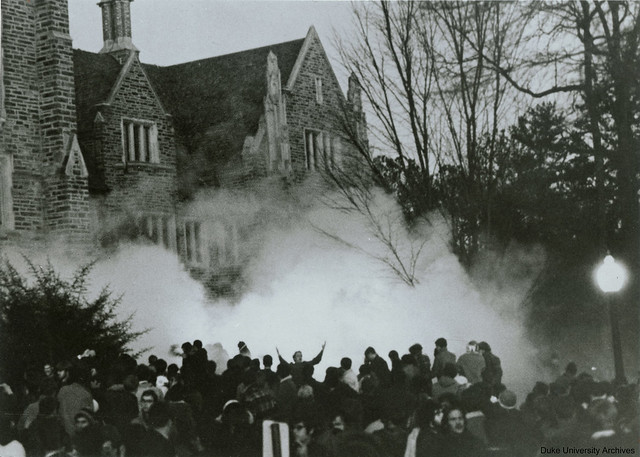Although there is a tendency – among those who have heard of the “Allen Building Takeover” – to think that the 1969 event was the one and only such “takeover,” the Allen Building has in fact been a site of protest throughout Duke’s history.

Moore, Herald. "Students leave the campus after vacating the Allen Building..." 2008. Durham Civil Rights Heritage Project.
The fairly late integration of Duke University in 1963 – a school that had segregated campus bathrooms and a “colored” section in Wallace Wade Stadium as late as 1962 – was only the beginning of Duke’s challenging race relations. The first black undergraduates to attend Duke have described the atmosphere as lonely and self-segregating. Campus social groups, such as fraternities and sororities, did not admit black students, and they were often not invited to social functions. Small in number, black students usually decided collectively what weekend social functions to attend, whether it was with a Duke social group that had extended an invitation or at the nearby historically black North Carolina College (now North Carolina Central University, or NCCU).
This icy atmosphere prompted the formation of the “Afro-American Society” in the fall of 1967, a body whose goal was to create a collective cultural base for African American students at Duke. Not long after its formation, in October, the Associated Students of Duke University (ASDU)’s condemnation of the university’s use of segregated off-campus facilities was overturned by a student referendum. Members of the AAS, appalled, demanded that the administration prohibit such patronization by 6pm on November 12th. If it did not, the AAS promised to “formulate and enact plans to disrupt the functioning of the university” (Yannella 1985, 8).
Professor William C. Turner, Ph. D. has described the Allen Building Takeover of 1969 – not the Silent Vigil of 1968 – as being the real “turning point”: “in the hiring of black faculty, in establishing African American Studies as a viable academic enterprise, in the forward movement of the school in becoming an international university rather than a good regional school. It was after the Allen Building Takeover that you begin to see this opening – this global perspective…students coming in…more women, more ethnicities” (Turner Interview, part 7). There was an impression that it was an event where black students claimed a voice and “a space in the university” (Croxton interview).

"Allen Building Takeover Crowd being tear-gassed." 13 February 1969. Duke University Archives, David M. Rubenstein Rare Book & Manuscript Library, Durham, NC. Flickr: Duke Yearlook. Accessed May 2012.
Daniel Walter also describes a more minor 1970 “takeover” of the Allen Building, led by a mix of blacks and whites, in order to discuss the reformulation of academic policy at Duke. Some students wanted to move to a Pass/Fail system so that they could spend more time reading and less time on “busy work.” The movement did not get far, but President Terry Sanford was very willing to take questions on the topic (Walter interview).
Works Consulted
Yannella, Don. 1985. Race Relations at Duke University and the Allen Building Takeover. Oral History Program, Duke University. Duke University Archives, Durham, NC.


Doing research for my novel and came across my own quote. Thanks!
My husband and I, 23 & 22 yrs old respectively – he was in grad school at UNC and I was a secretary putting him through – were at the lower right hand corner of the tear gas photo. We came over from Chapel Hill when I got off work. The African American students were singing “We Shall Overcome.” The rednecks were singing “Dixie.” It was not a hard decision as to who we would stand with. Then the riot police showed up – although no one was doing anything violent at all. They came from two directions, to the right of the bldg and then down the quad. When we ran from the first ones, the others were coming through the gas towards us. I had a purse, which I dropped. When I went back to pick it up, a tear gas canister landed two inches from my face. I inhaled in surprise. Bad idea! I was separated from my husband and was blinded by the gas with the cops bearing down on me. Suddenly a Duke student grabbed me and took me inside one of the men’s dorms. He washed my eyes out and we watched out the windows as the mayhem unfolded. Then my husband found me. Had to leave our coats at the dry cleaners on the way back into Chapel Hill. When the conservative faculty at the UNC Chemistry Dept where I worked found out we’d been there, the former head of the dept, a particularly unkind person, wanted to have me fired. But the newer head of the dept. wouldn’t let him.